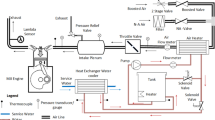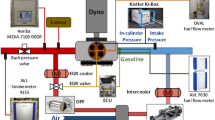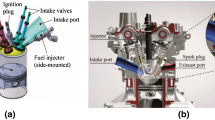Abstract
Recently, global warming caused by greenhouse gases has been highlighted, so many studies have been carried out for developing eco-friendly products. In the vehicle industry, various techniques have been developed for eco-friendly engines. A previous fuel injection system, injecting fuel at the intake port, had difficulty precisely controlling the air/fuel ratio in the cylinder. Therefore, the fuel injection system has been changed to a direct injection system injecting fuel directly inside the cylinder. Due to concerns about fossil fuel depletion and the instability of oil prices, various alternative fuels are currently becoming popular. Liquefied petroleum gas (LPG) is an alternative fuel that has similar characteristics to gasoline. LPG can be used in gasoline engines without sophisticated modification of the engine. For these reasons, the present work focuses on a numerical investigation of the combustion and emission characteristics of LPG direct injection (LPDI) engines by using tumble and swirl. For conducting the simulation, commercial software STAR-CD ver. 4.26 was used. The study was performed at the minimum spark advance for best torque (MBT) of the stoichiometric excess air ratio (λ = 1.0) and the lean-burn excess air ratio (λ = 1.5) with changes in the intake port geometry to induce in-cylinder flow changes.
Similar content being viewed by others
Abbreviations
- TDC:
-
top dead center
- BDC:
-
bottom dead center BTDC: before bottom dead center
- SFC:
-
specific fuel consumption
- CA:
-
crank angle
- PFI:
-
port fuel injection
- LPG:
-
liquefied petroleum gas
- LPDI:
-
LPG direct injection
- CO:
-
carbon monoxide
- NO:
-
nitrogen oxide
- SOI:
-
start of injection
- EOI:
-
end of injection
- MBT:
-
minimum spark advance for best torque
References
Bai, C. and Gosman, A. D. (1995). Development of methology for spray impinging simulation. SAE Paper No. 950283.
Bai, C. and Gosman, A. D. (1996). Mathematical modelling of wall films formed by impinging sprays. SAE Paper No. 960626.
Bayraktar, H. and Durgun, O. (2005). Investigating the effects of LPG on spark ignition engine combustion and performance. Energy Conversion and Management46, 13–14, 2317–2333.
Brehm, C. and Whitelaw, J. H. (1999). Air and fuel characteristics in the intake port of a SI engine. SAE Paper No. 1999-01-1491.
CD-adapco (2017). Methodolgy, Star-CD Ver. 4.14.
Colin, O. and Benkenida, A. (2004). The 3-zones extended coherent flame model (ECFM3Z) for computing premixed/diffusion combustion. Oil & Gas Science and Technology59, 6, 593–609.
Erkuş, B., Sürmen, A. and Karamangil, M. İ. (2013). A comparative study of carburation and injection fuel supply methods in an LPG-fuelled SI engine. Fuel, 107, 511–517.
Falfari, S., Brusiani, F. and Bianchi, M. (2012). Assessment of the influence of intake duct geometrical paramenters on the tumble motion generation in a small gasoline engine. SAE Paper No. 2012-32-0095.
Huang, Z., Wang, J., Liu, B., Zeng, K., Yu, J. and Jiang, D. (2007). Combustion characteristics of a direct-injection engine fueled with natural gas-hydrogen blends under various injection timings. Energy & Fuel20, 4, 1498–1504.
Hyun, G., Lee, D. and Goto, S. (2000). KIVA simulation for mixture formation process in an in-cylinder injected LPG SI engine. SAE Paper No. 2000-01-2805.
Jang, W., Ko, A., Baek, S., Jin, D., Choi, K., Myung, C. and Park, S. (2015). Study of regulated emissions and nanoparticle characteristics of light-duty direct-injection vehicles fueled with gasoline and liquefied petroleum gas in the new european driving cycle and the federal test procedure 75 driving cycle. Proc. Institution of Mechanical Engineers, Part D: J. Automobile Engineering299, 1, 25–37.
Jennifer, C. B. and Rolf, D. R. (1999). Modeling Spray atomization with the kelvin-helmholtz/rayleigh-taylor hybrid model. Atomization and Sprays9, 6, 623–650.
Kim, K., Kim, J., Oh, S., Kim, C. and Lee, Y. (2016a). Lower particulate matter emissions with a stoichiometric LPG direct injection engine. Fuel, 187, 197–210.
Kim, T. Y., Park, C., Oh, S. and Cho, G. (2016b). The effects of stratified lean combustion and exhaust gas recirculation on combustion and emission characteristics of an LPG direct injection engine. Energy115, Part 1, 386–396.
Li, L., Wang, Z., Deng, B., Han, Y. and Wang, H. (2002). Combustoin and emissions characteristics of a small spark-ignited LPG engine. SAE Paper No. 2002-01-1738.
Myung, C., Kim, J., Choi, K., Hwang, I. G. and Park, S. (2012a). Compartive study of engine control strategies for particulate emissions from direct injection light-duty vehicle fueled with gasoline and liquid phase liquefied petroleum gas (LPG). Fuel, 94, 348–355.
Myung, C., Choi, K., Kim, J., Lim, Y., Lee, J. and Park, S. (2012b). Comparative study of regulated and unregulated toxic emissions characteristics from a spark ignition direct injection light-duty vehicle fueled with gasoline and liquid phase LPG. Energy44, 1, 189–196.
Ravi, K., Bhasker, J. B., Alexander, J. and Porpatham, E. (2018). CFD study and experimental investigation of piston geometry induced in-cylinder charge motion on LPG fueled lean burn spark ignition engine. Fuel, 213, 1–11.
Reitz, R. D. and Diwakar, R. (1986). Effect of drop breakup on fuel sprays. SAE Paper No. 860469.
Siemens (2016). Star Methodology Ver. 4.26.
Stein, R. A., House, C. J. and Leone, T. G. (2009). Optimal use of E85 in a turbocharged direct injection engine. SAE Pape No. 2009-01-1490.
Wang, G., Yu, W., Li, X., Su, Y. and Wu, W. (2019). Experimental and numerical study on the influence of intake swirl on fuel spray and in-cylinder combustion characteristics on large bore diesel engie. Fuel, 237, 209–221.
Wu, Y., Nguyen, M. and Tran, A. (2010). Effect of swirl ratio on performance of semi-direcrt injection SI engine. Proc. WSEAS Int. Conf., Taipei, China.
Yakhot, V., Orszag, S. A., Gatski, T. B. and Speziate, C. G. (1992). Development of turbulence models for shear flows by a double expansion technique. Physics of Fluids A4, 7, 1510–1520.
Acknowledgements
This study was supported by the Korea LPG Association, the CEFV (Center for Environmentally Friendly Vehicle) as Global-Top Project of KMOE (Ministry of Environment, KOREA), a Korea University Grant, and the BK21 Plus Program (21A20131712520) through the National Research Foundation (NRF) funded by the Ministry of Education of Korea. The authors gratefully acknowledge all of those.
Author information
Authors and Affiliations
Corresponding author
Additional information
Publisher’s Note
Springer Nature remains neutral with regard to jurisdictional claims in published maps and institutional affiliations.
Rights and permissions
About this article
Cite this article
Kim, H., Lee, S.Y., Kim, H.J. et al. Numerical Study on the Effects of Tumble and Swirl on Combustion and Emission Characteristics of an LPG Direct Injection Engine. Int.J Automot. Technol. 21, 623–632 (2020). https://doi.org/10.1007/s12239-020-0059-y
Received:
Revised:
Accepted:
Published:
Issue Date:
DOI: https://doi.org/10.1007/s12239-020-0059-y




